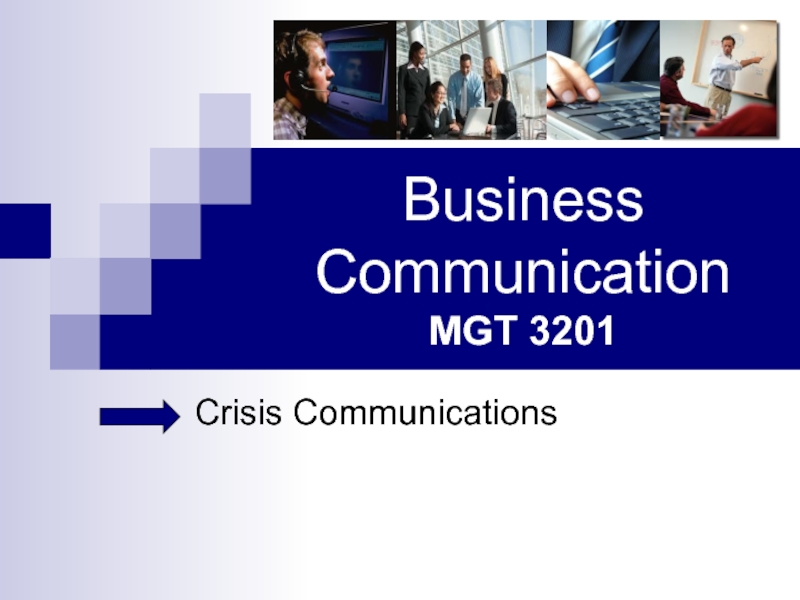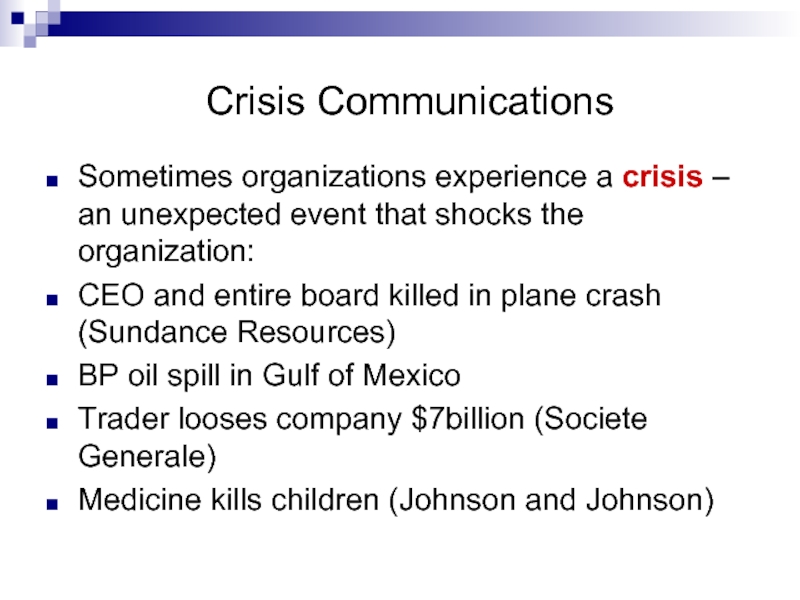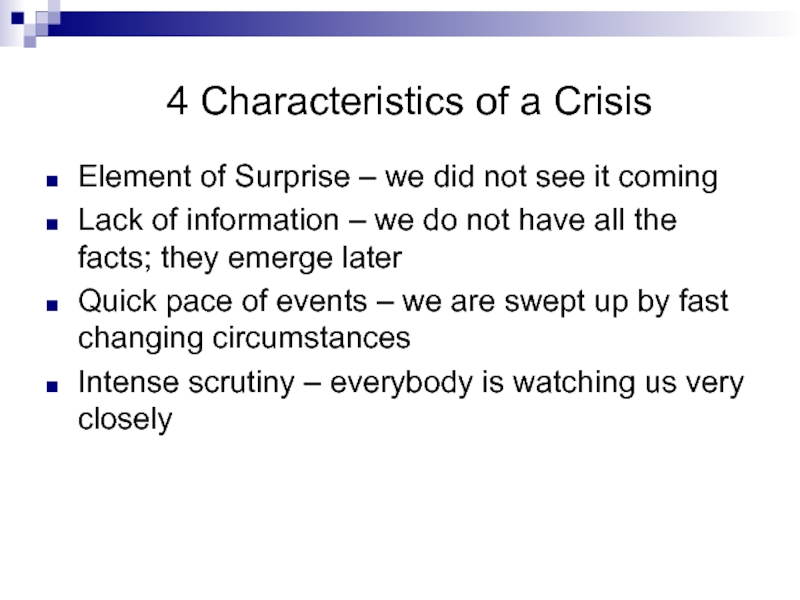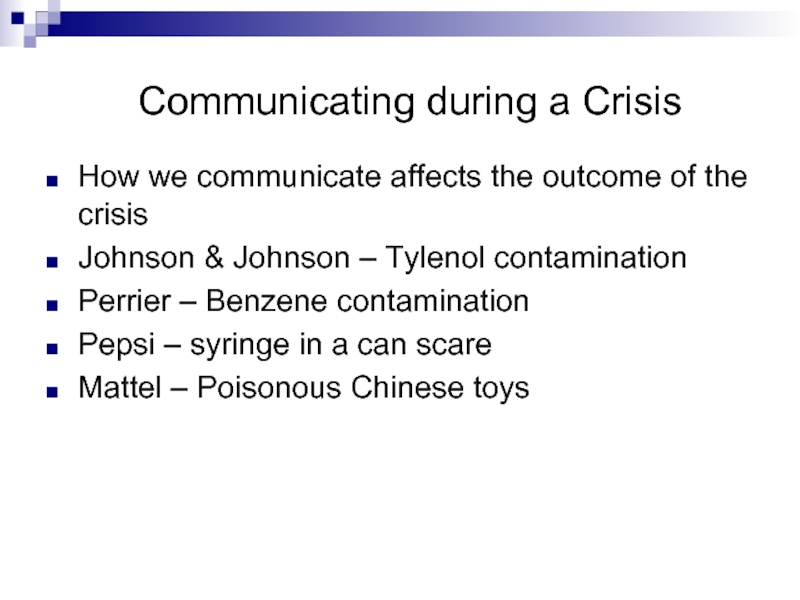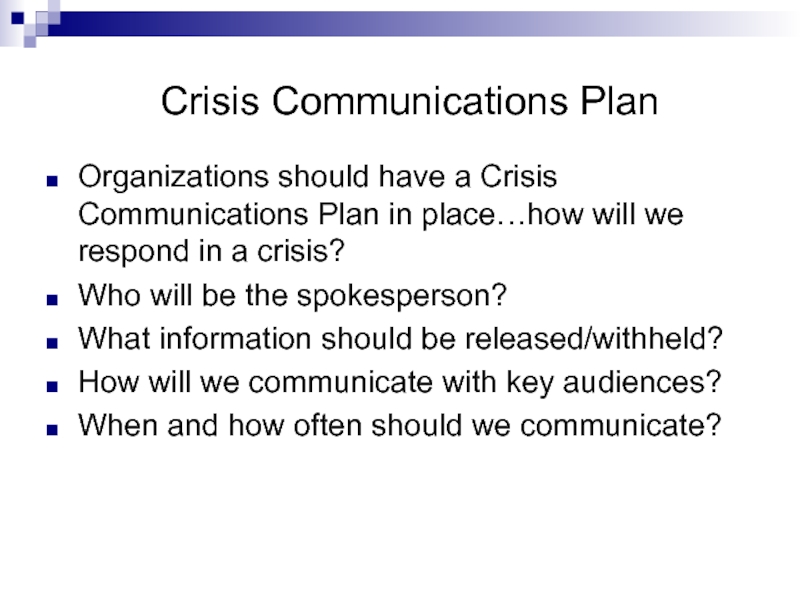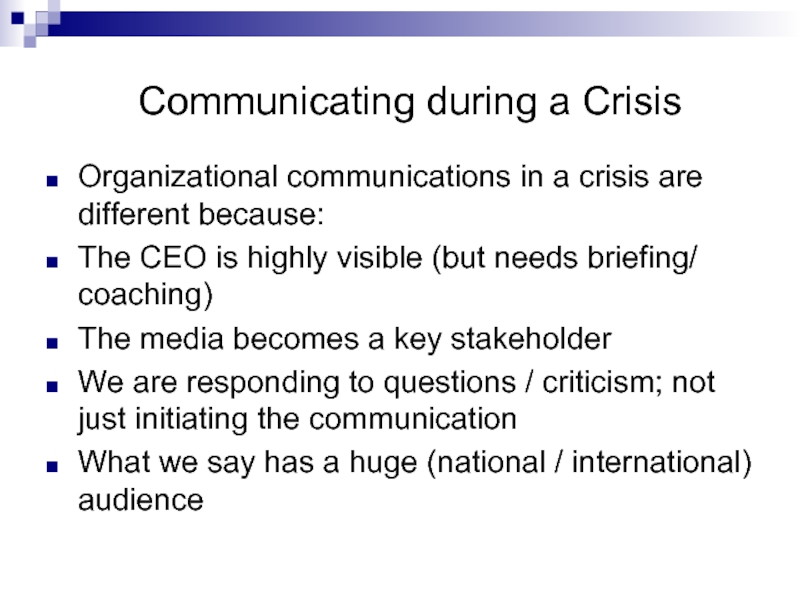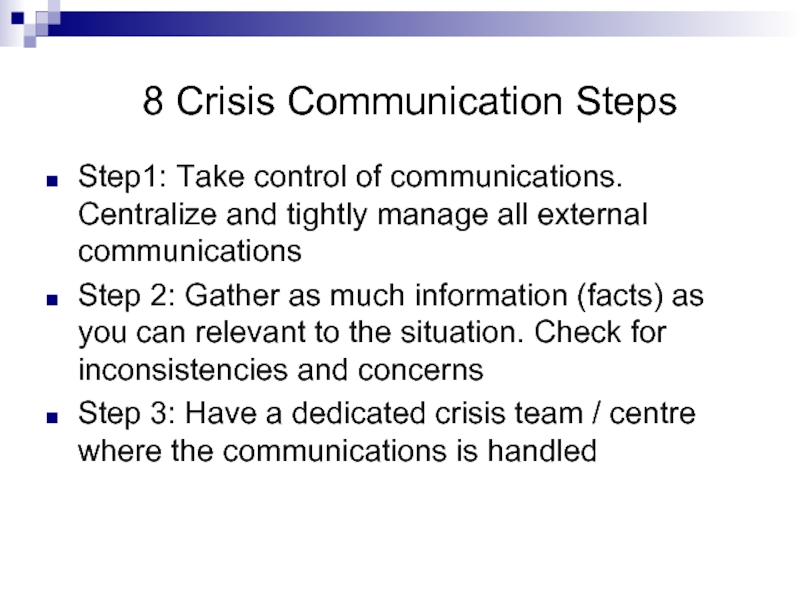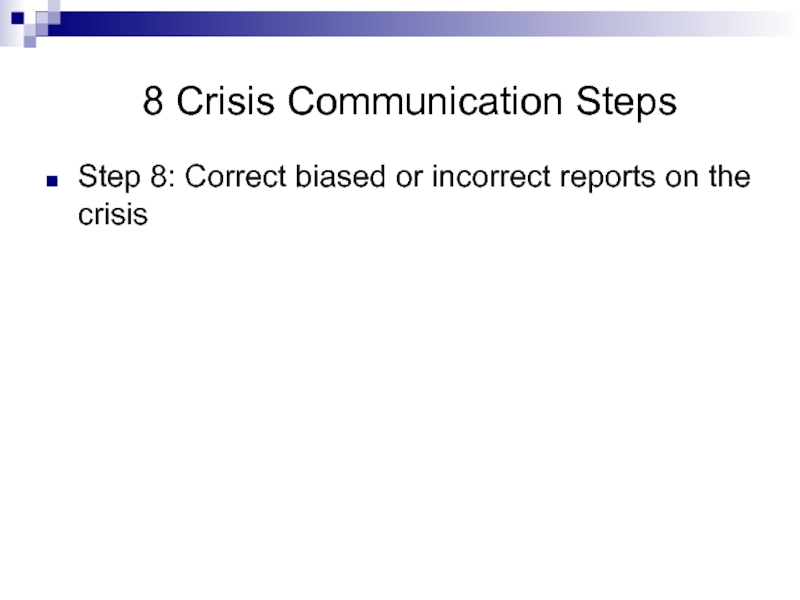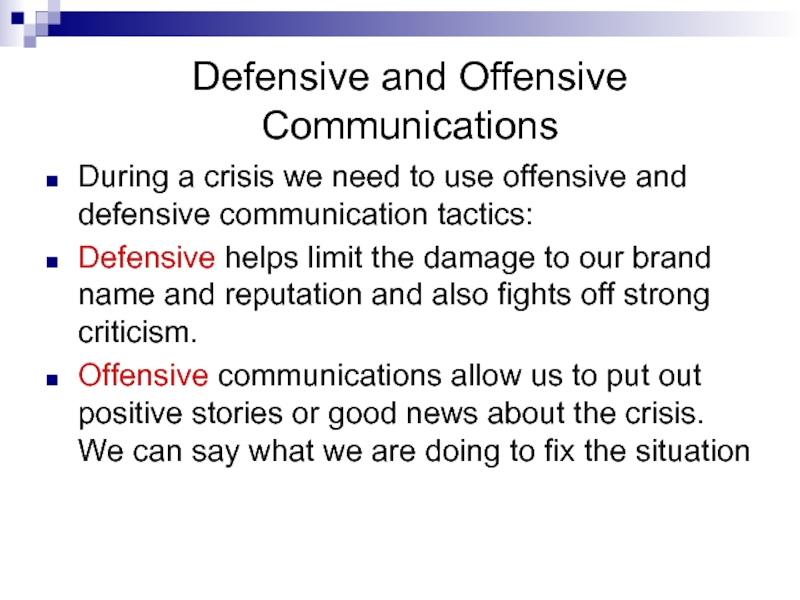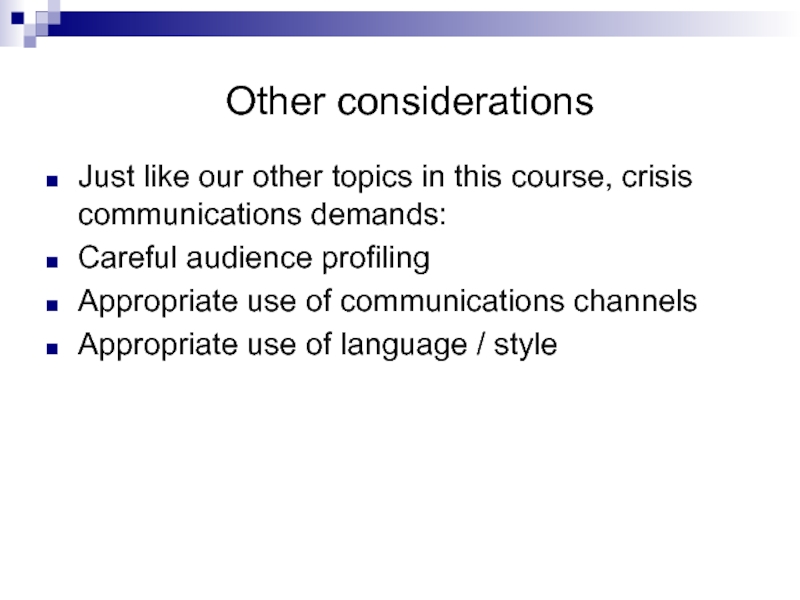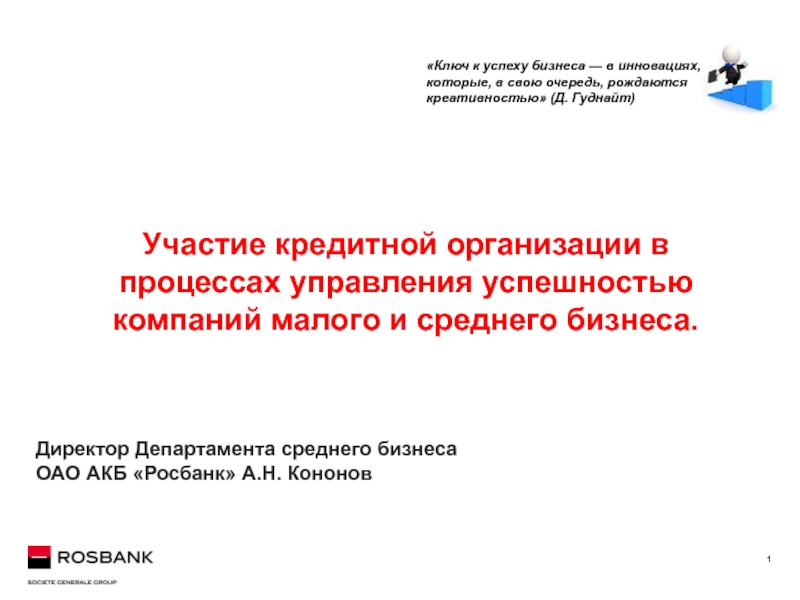- Главная
- Разное
- Дизайн
- Бизнес и предпринимательство
- Аналитика
- Образование
- Развлечения
- Красота и здоровье
- Финансы
- Государство
- Путешествия
- Спорт
- Недвижимость
- Армия
- Графика
- Культурология
- Еда и кулинария
- Лингвистика
- Английский язык
- Астрономия
- Алгебра
- Биология
- География
- Детские презентации
- Информатика
- История
- Литература
- Маркетинг
- Математика
- Медицина
- Менеджмент
- Музыка
- МХК
- Немецкий язык
- ОБЖ
- Обществознание
- Окружающий мир
- Педагогика
- Русский язык
- Технология
- Физика
- Философия
- Химия
- Шаблоны, картинки для презентаций
- Экология
- Экономика
- Юриспруденция
Business Communications (lecture 14). Crisis Communications презентация
Содержание
- 1. Business Communications (lecture 14). Crisis Communications
- 2. Crisis Communications Sometimes organizations experience a crisis
- 3. 4 Characteristics of a Crisis Element of
- 4. Communicating during a Crisis How we communicate
- 5. Crisis Communications Plan Organizations should have a
- 6. Communicating during a Crisis Organizational communications in
- 7. 8 Crisis Communication Steps Step1: Take control
- 8. 8 Crisis Communication Steps Step 4: Communicate
- 9. 8 Crisis Communication Steps Step 8: Correct biased or incorrect reports on the crisis
- 10. Defensive and Offensive Communications During a crisis
- 11. Other considerations Just like our other topics
- 12. Case Study – Crisis Communications Applying what
Слайд 2Crisis Communications
Sometimes organizations experience a crisis – an unexpected event that
shocks the organization:
CEO and entire board killed in plane crash (Sundance Resources)
BP oil spill in Gulf of Mexico
Trader looses company $7billion (Societe Generale)
Medicine kills children (Johnson and Johnson)
CEO and entire board killed in plane crash (Sundance Resources)
BP oil spill in Gulf of Mexico
Trader looses company $7billion (Societe Generale)
Medicine kills children (Johnson and Johnson)
Слайд 34 Characteristics of a Crisis
Element of Surprise – we did not
see it coming
Lack of information – we do not have all the facts; they emerge later
Quick pace of events – we are swept up by fast changing circumstances
Intense scrutiny – everybody is watching us very closely
Lack of information – we do not have all the facts; they emerge later
Quick pace of events – we are swept up by fast changing circumstances
Intense scrutiny – everybody is watching us very closely
Слайд 4Communicating during a Crisis
How we communicate affects the outcome of the
crisis
Johnson & Johnson – Tylenol contamination
Perrier – Benzene contamination
Pepsi – syringe in a can scare
Mattel – Poisonous Chinese toys
Johnson & Johnson – Tylenol contamination
Perrier – Benzene contamination
Pepsi – syringe in a can scare
Mattel – Poisonous Chinese toys
Слайд 5Crisis Communications Plan
Organizations should have a Crisis Communications Plan in place…how
will we respond in a crisis?
Who will be the spokesperson?
What information should be released/withheld?
How will we communicate with key audiences?
When and how often should we communicate?
Who will be the spokesperson?
What information should be released/withheld?
How will we communicate with key audiences?
When and how often should we communicate?
Слайд 6Communicating during a Crisis
Organizational communications in a crisis are different because:
The
CEO is highly visible (but needs briefing/ coaching)
The media becomes a key stakeholder
We are responding to questions / criticism; not just initiating the communication
What we say has a huge (national / international) audience
The media becomes a key stakeholder
We are responding to questions / criticism; not just initiating the communication
What we say has a huge (national / international) audience
Слайд 78 Crisis Communication Steps
Step1: Take control of communications. Centralize and tightly
manage all external communications
Step 2: Gather as much information (facts) as you can relevant to the situation. Check for inconsistencies and concerns
Step 3: Have a dedicated crisis team / centre where the communications is handled
Step 2: Gather as much information (facts) as you can relevant to the situation. Check for inconsistencies and concerns
Step 3: Have a dedicated crisis team / centre where the communications is handled
Слайд 88 Crisis Communication Steps
Step 4: Communicate early, clearly, honestly and with
details to all stakeholder groups. Be consistent in your messages
Step 5: Take the offensive in communicating your position
Step 6: Understand the media’s mission in a crisis
Step 7: Communicate internally to maintain employee morale and reassure employees
Step 5: Take the offensive in communicating your position
Step 6: Understand the media’s mission in a crisis
Step 7: Communicate internally to maintain employee morale and reassure employees
Слайд 10Defensive and Offensive Communications
During a crisis we need to use offensive
and defensive communication tactics:
Defensive helps limit the damage to our brand name and reputation and also fights off strong criticism.
Offensive communications allow us to put out positive stories or good news about the crisis. We can say what we are doing to fix the situation
Defensive helps limit the damage to our brand name and reputation and also fights off strong criticism.
Offensive communications allow us to put out positive stories or good news about the crisis. We can say what we are doing to fix the situation
Слайд 11Other considerations
Just like our other topics in this course, crisis communications
demands:
Careful audience profiling
Appropriate use of communications channels
Appropriate use of language / style
Careful audience profiling
Appropriate use of communications channels
Appropriate use of language / style
Слайд 12Case Study – Crisis Communications
Applying what you now know about Crisis
Communications, you will work in small groups on a case study. The case is called “Chicago Transit Authority” and is also on the L Drive in the ‘Class activities’ folder.
